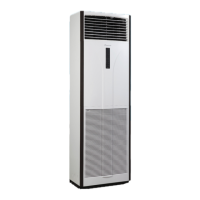Special Precautions When Dealing With R410a Unit
Refrigerant Piping
Outdoor Unit 3 ways valve
Allen key
Service Port
Flare nut
HIGH PRESSURE GAUGE
GAUGE MANIFOLD
LOW PRESSURE GAUGE
HANDLE HI (ALWAYS CLOSED)
CHARGE HOSE
-760mmHg
HANDLE LO
CHARGE HOSE
VACUUM PUMP
ADAPTER FOR
COUNTER FLOW
PREVENTION
CHECK
VALVE
LIQUID VALVE
HIGH PRESSURE GAUGE
LOW PRESSURE GAUGE
GAUGE MANIFOLD
-760mmHg
HANDLE LO
HANDLE HI (ALWAYS CLOSED)
CHARGE HOSE
CHARGE HOSE
CHECK
VALVE
CONFIGURATION OF AIR PURGE
BY CHARGING
GAS VALVE
(3-WAY)
CONFIGURATION OF AIR PURGE
BY CHARGING
Vacuuming And Charging
LIQUID VALVE
GAS VALVE
(3-WAY)
R410A is a new HFC refrigerant which does not
damage the ozone layer. The working pressure of this
new refrigerant is 1.6 times higher than conventional
refrigerant (R22), thus proper installation / servicing
is essential.
•
Never use refrigerant other than R410A in an air
conditioner which is designed to operate with R410A.
• POE or PVE oil is used as lubricant for R410A
compressor, which is different from the mineral oil
used for R22 compressor. During installation or
servicing, extra precaution must be taken not to
expose the R410A system too long to moist air.
Residual POE or PVE oil in the piping and
components can absorb moisture from the air.
• To prevent mischarging, the diameter of the service
port on the flare valve is different from that of R22.
• Use tools and materials exclusively for refrigerant
R410A. Tools exclusively for R410A are manifold
valve, charging hose, pressure gauge, gas leak
detector, flare tools, torque wrench, vacuum pump
and refrigerant cylinder.
• As an R410A air conditioner incurs higher pressure
than R22 units, it is essential to choose the copper
pipes correctly. Never use copper pipes thinner than
0.8mm even though they are available in the market.
• If the refrigerant gas leakage occurs during
installation / servicing, be sure to ventilate fully. If the
refrigerant gas comes into contact with fire, a
poisonous gas may occur.
• When installing or removing an air conditioner, do not
allow air or moisture to remain in the refrigerant
cycle.
Purging the piping and the indoor unit
Except for the outdoor unit which is pre-charged with
refrigerant, the indoor unit and the refrigerant connection
pipes must be air-purged because the air containing
moisture that remains in the refrigerant cycle may cause
malfunction of the compressor.
•
Remove the caps from the valve and the service port.
•
Connect the center of the charging gauge to the vacuum pump.
• Connect the charging gauge to the service port of the
3-way valve.
• Start the vacuum pump. Evacuate for approximately
30
minutes. The evacuation time varies with different
vacuum
pump capacity. Confirm that the
charging gaugeneedle has
moved towards -760mmHg.
Caution
• If the gauge needle does not move to -760mmHg, be sure
to check for leakage at flare type connection of the indoor
and outdoor unit and repair the leak before proceeding to
the next step.
• Close the valve of the changing gauge and stop the
vacuum pump.
• On the outdoor unit, open the suction valve and liquid
valve (in anti-clockwise direction) with 4mm key for
hexagon sacked screw.
Charge Operation
This operation must be done by using a gas cylinder and
a precise weighing machine. The additional charge is
topped-up into the outdoor unit using the suction valve via
the service port.
• Remove the service port cap.
• Connect the low pressure side of the charging gauge to
the suction service port center of the cylinder tank and
close the high pressure side of the gauge. Purge the air
from the service hose.
• Start the air conditioner unit.
• Open the gas cylinder and low pressure charging valve.
•
When the required refrigerant quantity is pumped into the
unit, close the low pressure side and the gas cylinder valve.
• Disconnect the service hose from service port. Put back
the service port cap.

